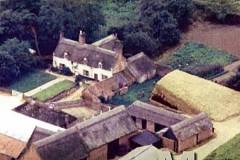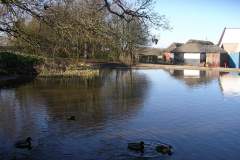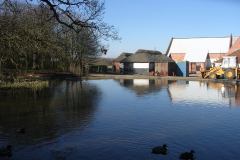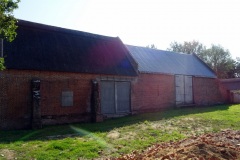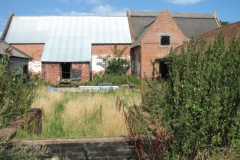Moregrove Manor of Martham
There were two Manors in Martham. The Prior’s Manor to the south of the village centred at what we now know as Hall Road and the smaller Manor of Moregrove to the north of the village.
The history of Moregrove is long and complex, the land there has seen change through many centuries and occupiers of the farm are connected to many of the most prominent families associated with the village. In many ways the history of Moregrove encapsulates the history of Martham itself. As the history is long and complicated I have divided it into five parts that you can jump between by clicking on a section of your choice. The five parts are as follows:-
Part 1 – Prehistoric finds from the area that became Moregrove.
Part 2 – The Gunton family and their association with Moregrove to about 1350
Part 3 – From 1350 to 1799. (The Cobham College/Knightley/ Holkham period).
Part 4 – From 1800 to 1899. (The Creasey/ Garnham/ Rising/ Pearse/ Palmer period).
Part 5 – From 1900 onwards (including the War Years by Joe Larter)
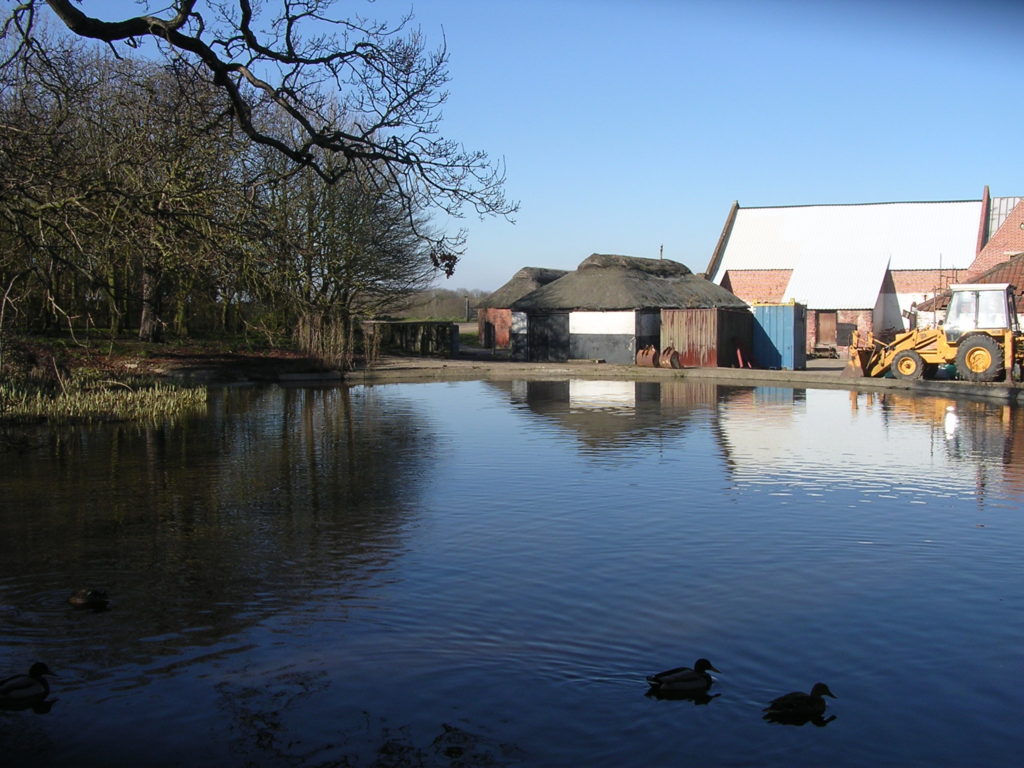
Part 1. Prehistoric finds from the area that became Moregrove
Astonishing though it may sound historic evidence of man has been found in the Moregrove area stretching back to the Ice Age and Stone Age. Moregrove did not exist then of course and neither did Martham. The shape of the east of England would have been completely different.
The finds date from a time of rapid climate change, when land which once existed between England and the Netherlands was inundated by seawater, marsh and watery inlets. The people were hunter-gathers and followed the animals. One piece of high ground they came across was the equivalent of the east coast around the north of the Isle of Flegg. It may have been temporary in the scale of thousands of years but people did live there on what may have been the first rise of land above the water level with views out to sea giving them access to the rich natural pickings in the intertidal zone.
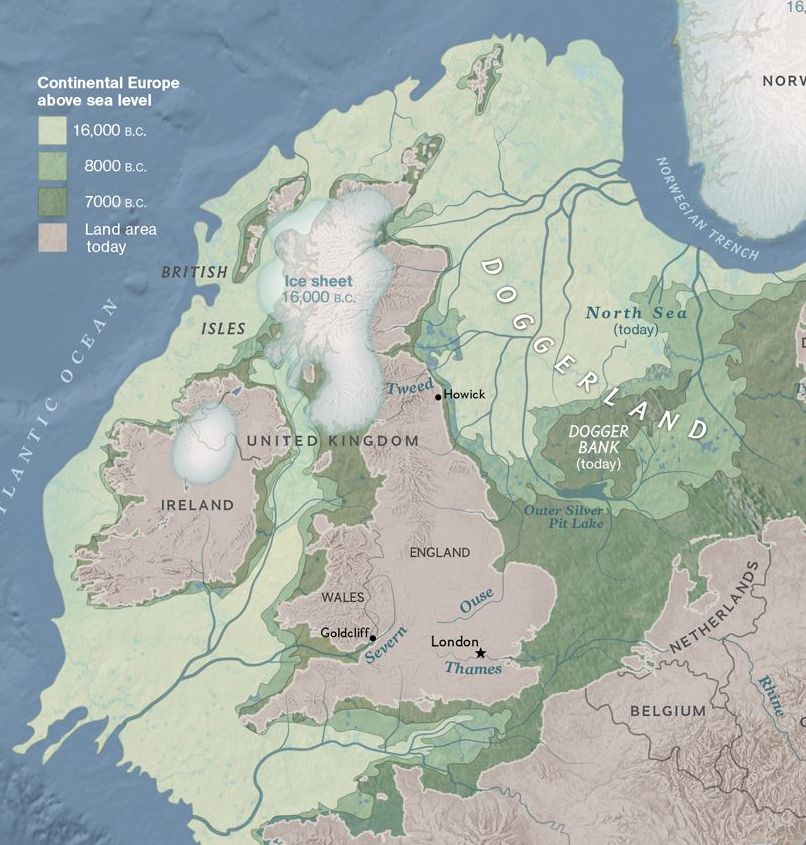
At the end of the last ice age, Britain formed the northwest corner of an icy continent. Warming climate exposed a vast continental shelf for humans to inhabit. Further warming and rising seas gradually flooded low-lying lands. Some 8,200 years ago, a catastrophic release of water from glacial lakes and a tsunami from a submarine landslide off Norway inundated whatever remained of Doggerland flooding the North Sea and splitting Britain from Europe.
Building work at Moregrove has turned up Stone Age knives and scrapers and a Mesolithic knife blade which has two different notched scrapers on the back edge making it a type of prehistoric multi-tool. The soil from trench work revealed several other flint knives and scrapers. Other finds include an arrowhead from the Neolithic period which had been buried with a pair of wild boar tusks in soil which still contained charcoal. In these terms Moregrove must be the oldest occupational site in Martham.

Part 2 – The Gunton Family and Moregrove
The Gunton family had a strong presence at Moregrove and considerable influence on the village. There were two Gunton estates. One was Gunton, near Lowestoft in Suffolk and the other, the topic of this page, is in the Erpingham District of North Norfolk and is about 4½ miles north west of North Walsham and 5½ north of Aylsham. Some early records call Moregrove the Gunton Estate. This is not an error as the manor was held by the Gunton family for many generations from the 12th to early 14th centuries.
Piecing together the Gunton family genealogy and land holdings is complex as records going back that far are hazy, have been subject to individual interpretation, which include contradictions, and there are large gaps between dates. To make research more difficult over the generations the family repeatedly called sons Matthew and Roger and several are recorded without any dates at all. Most of the following information comes from antiquarians of the 1700’s which means they collated it 400 to 500 years after the actual events giving rise to obvious problems but they remain the only sources available. The main compiler was Francis Blomefield who you can read more about HERE. These are some of the facts:
Both Martham and Gunton were granted to William Beaufoe, Bishop of Thetford(18), by William the Conqueror (1066-1087) and were held in his own right as a lay fee(15). When Bishop William Beaufoe died in about 1091 he gave Martham, with many other manors, to his Priory at Thetford. William was succeeded by Bishop Herbert de Losinga(16) and in about 1101 he gave the Manor (of Moregrove) to the Gunton family. The reason he did this is unknown but presumably the family did some great service for him. Bishop Losinga moved the See(17) from Thetford to Norwich in 1094/95.(16).
In 1122 we come across the first mention of a Mathew de Gunton being recorded as Lord of the Manor (of Moregrove) in the reign of Henry I. The family holdings also included land at Hemsby, Dalling, Worstead, and Caister(1&8).
A later Mathew de Gunton (probably the great grandson of the above) had two sons who were Roger and Thomas. In about 1160 the Gunton Manor in Martham (Moregrove) included St Mary the Virgin and Roger De Gunton gave the church and all its appurtenances to the priory and convent of Norwich(20). It was not unusual for landowners in the 12th century to grant their churches to ecclesiastical institutions, both as a pious act and in the expectation of prayers being said for the redemption of their soul.
In 1224 another Mathew de Gunton, a descendant of Roger de Gunton, held possession of the manor of Gunton and also manor lands in Martham, that must have been Moregrove although it was not called by that name at the time. As lord of the manor of Moregrove Matthew had the right to appoint rectors (called an advowson) but in 1224 he gave the right to the Monastery and Priory at Norwich Cathedral on the understanding that the monks would pray for his soul and the souls of his family and servants.(21)
Matthew died in 1276. He had been married to Isabell Castre (Caister) daughter and heir of Sir Robert de Castre. They had two sons and five daughters. One son was called Roger who appears to have died before his brother John who inherited Moregrove. John died without issue soon afterwards in 1277 and his inheritance, which included Moregrove, reverted to his sisters(1). They were:
- Juliana, who married Simon Poche or Peche.
- Margery, also known as Margaret, who married John de Melwood or Methwold.
- Katherine, or Catherine, who married Simon de Lincoln.
- Sibill who married 1. John de Gimingham & 2 William de Crostweyt or Crosthwaite.
- Isabell (who was sometimes recorded as Elizabeth) who married 1. Roger de Bavent & 2. William de Stalham & 3. Laurence de Huntingfeld or Huntingfield.
All the daughters made good marriages but it seems that none of them ever lived at Martham. They are important however because all five held Moregrove by frank pledge which was a system of joint ownership of land etc which was common in England throughout the early Middle Ages, the essential characteristics were the sharing of responsibility among persons connected in tithings. There are subsequent mentions of some of them in relationship to Moregrove.
In 1287 Roger de Bavent and his wife Isabell disputed the terms of the frank pledge in the manor of Moregrove with John de Methwold & Margery; Simon de Lincoln & Katherine; John de Gimingham & Sibil; and Simon Peche & Juliana. From this we have further confirmation that all five sisters and their husbands owned Moregrove jointly and had sufficient interest in it to dispute the frank pledge arrangements.
The Stowe Survey of 1292 tells us that some members of the Gunton family had adopted the name ‘de Martham’(5) which indicates that they actually lived in the village. Robert de Martham appears in various charters in the late 13th century and the Stowe Survey records him as living at Moregrove Field. It was not unusual at that time for people to take the name of the place they lived. Robert seems to have been born a ‘Gunton’ and changed his name to ‘of Martham’. This is the first recorded use of the manor being called Moregrove which confirms its status and that it had a manor house. The house was unlikely to have been all that grand. There was no stone in Norfolk so any mid 13th century house would probably have made use of locally available materials like wood and reed. At a time when most people lived in a one roomed cottage any house with two floors would have been considered grand and it may have looked a tidier version of this:
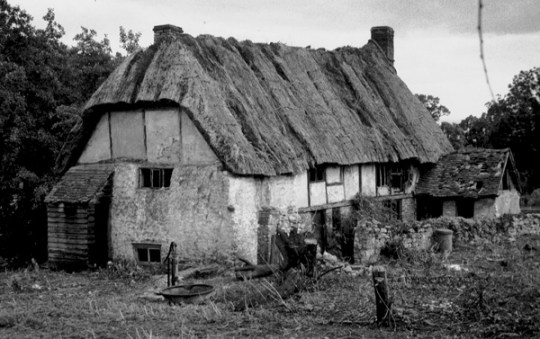
The split ownership of Moregrove between the five sisters then became complex not least because ownership would have been held in the names of their husbands. Subsequent dates of death and inheritance are not clear but there are two related records by Blomefield as follows:-
An important transaction to the history of Moregrove took place in 1316, when John the son of Sibill and her husband William de Crostweyt (Crosthwaite) sold (their portion of Moregrove) lands in Martham to Robert the son of Warine (William?) de Martham. We can see from this that some of the shares the sisters held in Moregrove were changing.
Meanwhile on another side of the family in 1322, there are records that hint that a Laurence de Huntingfeld held part of the Manor of Moregrove from, Isabell, (the former wife of Roger de Bavent) and that they had married(1). There was a dispute between the Prior and Laurence de Huntingfeld based on both of them claiming services from some of their tenants which arose after the Prior had passed lands and services to Laurence. Some of the land belonging to each manor lay intermingled in the open fields and as a result some tenants were obliged to do service to both Lords which was deemed to be ‘irrational and without justice’. The Prior and Laurence agreed they should only work for one and made suitable arrangements1&5.
Also, in 1322, Bartholomew, a son of Laurence de Huntingfeld gave his interests in the Moregrove Manor to the Prior of Norwich. In 1347 Thomas de Huntingfeld the brother of Bartholomew owned half the Manor of Moregrove after his father Laurence de Huntingfeld had died.
In 1342 another Robert de Martham, probably a descendant of the earlier Robert, gave the Abbess of the Nuns of St. Clare, 20 marks per annum of his income from lands and tenements at Moregrove, Horsey, Repps, and Bastwick, during the lifetime of Catherine, late wife of John de Ingham deceased, she being then a nun there. It may be that Robert de Martham purchased or (if he was a Gunton) inherited other parts of the manor from his ancestors. The manor grew to include extensive land holdings to the north on both sides of the River Thurne and marshes at Horsey, Repps and Bastwick. The marshes provided pasture for his cattle which included a bullock and fifteen heifers(11). There are no further records (that I have found so far) relating to the Guntons and because their land ownership passed down the female line, the Gunton name died out.
Summary
- In about 1160 the Gunton/Moregrove manor included St Mary the Virgin which Roger De Gunton gave to the Priory and Convent of Norwich.
- In 1224 Matthew de Gunton was lord of the Manor of Moregrove and had the right to appoint rectors which he gave to the Monastery and Priory at Norwich Cathedral on the understanding that the monks would pray for his soul. He also gave the church nine acres of land near the church.
- Sometime before 1292 Roger de Gunton, the son of Matthew, gave the Cathedral at Norwich a house, probably for a rectory, at Martham plus 12 acres of adjoining arable land.
- They demonstrated pious acts over many years across generations.
- The above events prove the Gunton family owned land in the village centred at Moregrove.
Part 3. 1350 to 1799 (Cobham College/ Knightley/ Holkham period)
The current owner of Moregrove, Jeremy Moore, has discovered the remains of original stonework on the site of an impressive English decorated Gothic style stone-built house that dates from 1300 to 1349. His finds include a whole wall that had fallen into the pond that may have been used as a moat at the time or for a fish supply for the house. He has recovered stone mullions from tall leaded windows. Napped flint bricks have also been discovered. The size of the lintels indicate that the walls would have been about 2ft thick and were decorated outside in white lime wash and inside in blue cobalt. This raises the intriguing possibility that the replacement manor house may have been built at the same time as the known 14th/15th century St Mary’s Church improvements taking advantage of stonework and masonry skills available for both at the same time. The photographs below show some of the stonework that Jeremy has found.
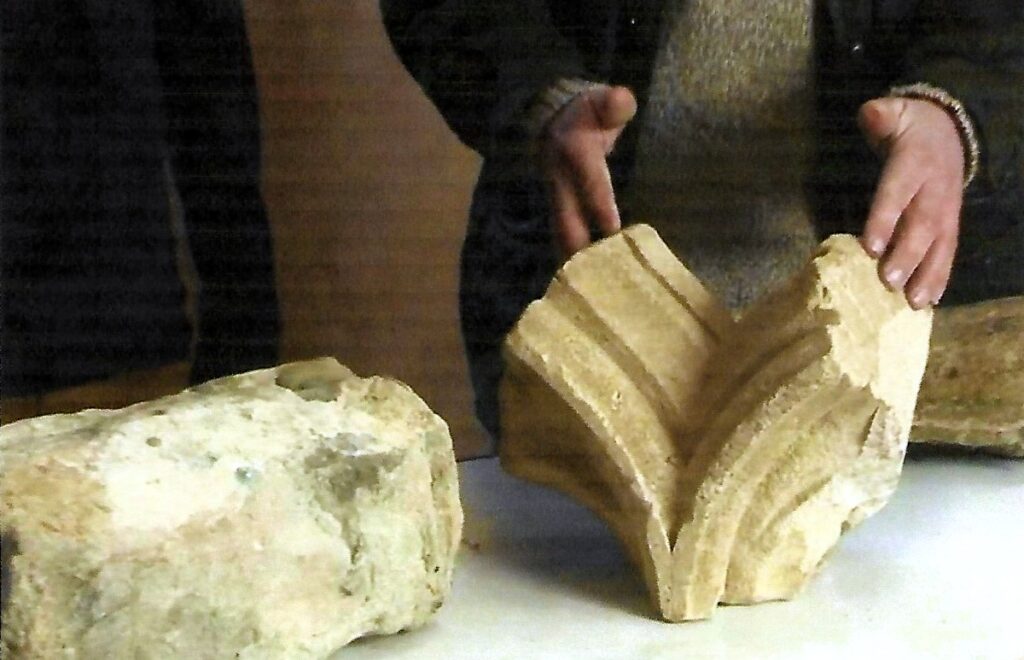
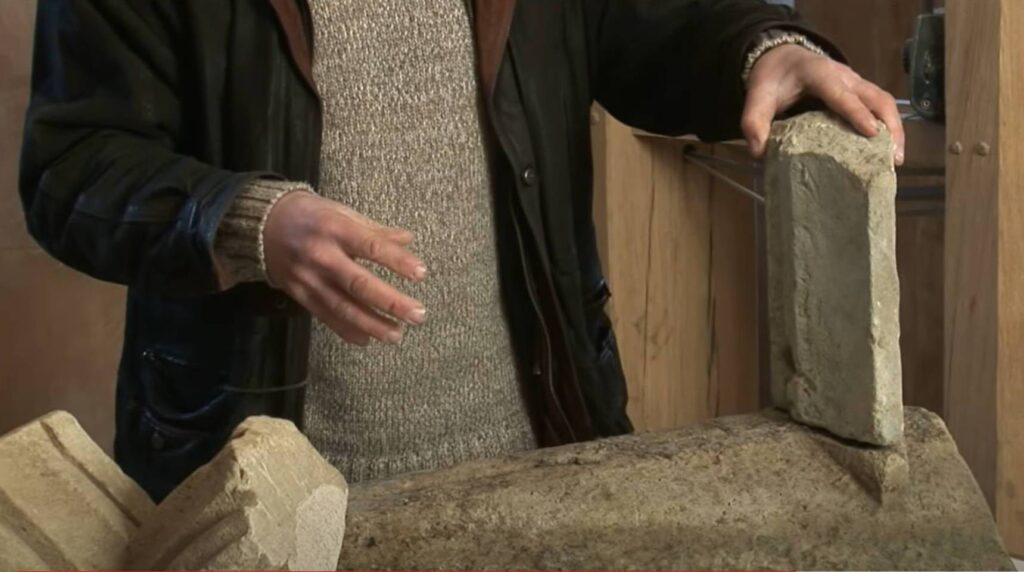
Cobham College Manor.
Cobham College Manor was said to be in the area of what is now the fishing pits to the east of the boat dyke staithe and the north end of Ferrygate next to the River Thurne but also included a valuable fishery near the present Martham Boat Building and Development boatyard at Cess on the River Thurne. In around 1362 the land, or manor, came into the ownership of Sir Laurence De Burley who gave it, no doubt for the redemption of his soul, to the College of Cobham in Kent. This may have been a pious gift but it seems it was difficult for them to manage from 150 miles away and after long detracted negotiations an exchange was arranged in 1380 by which the Prior of Norwich acquired the Cobham College Manor in Martham and gave to the College the Church of Chalke in Kent which was owned by the Cathedral Priory.
Despite being owned by the Prior of Norwich the former Cobham College land and the fishery in particularly appears to have been rented to the Moregrove Manor and in 1404 the fishery was let by the Prior for an annual rent of £5 6s 8d.
There is a dearth of records for Moregrove Manor during the second half of the 14th century and the whole of the 15th century. The Black Death took hold locally in 1349-50 and less than half the normal amount of hoeing and harvesting services were performed on the Prior’s Manor. We don’t know how the ‘Death’ affected Moregrove and this may have been because many bailiffs, priests, and scribes died as well as tenants resulting in harvest and land transaction records going unrecorded. To see more about how the Black Death affected Martham click HERE.
Thomas Drake leased the Prior’s Manor in 1425 and it included the Cobham fishery which was previously part of Moregrove; it is not clear if his lease included Moregrove as well which it may have because the loss of almost a generation of young people through the Black Death resulted in a shortage of alternative tenants(5).
Morgrave & Knightley
There then followed another long period, of about 70 years, with a lack of records relating to Moregrove. We next pick up records again in the late 15th or early 16th century when Moregrove passed into the hands of the LeStrange (or Le Straunge) family of Hunstanton. On 20th November 1513 John LeStrange, acting as Executor for his brother Robert’s estate, sold the Manor of Moregrove, plus land in West Somerton, Winterton, Repps, Clippesby, Rollesby, Heigham and Horsey for £105 to William Knightley.
William Knightley was born in about 1486 at St Peter Parmentergate in Norwich and became a lawyer and was not only the Lord of the Manor of Moregrove when he died in 1548 but also owned the Manors of Meys and Cawston. He left them to his wife, Margaret Anne Agnes, nee Hare and they were subsequently inherited by their son George Knightley, Esq. who became the Lord and also owned land at Hemsby and Clippesby. During this period the estate was known as the Morgrave & Knightleyes Manor (mostly spelt Knightley). There has been some speculation as to what the name Morgrave meant but it was probably no more than the way old English was drafted at the time but in any case the name has remained in use on and off ever since. For consistency I will continue to call it by its modern spelling of Moregrove.
The Manor consisted of sixty acres with the Manor house and its pond overlooking vast tracks of marsh and reed-bed in the middle of Moregrove Field. There were thirty tenants who held land of the manor in the village fields. The marshes provided a valuable asset and the Knightleys must have taken a serious interest in their economic value. The surprisingly high value of the marsh products was borne out by the Cathedral Priory’s policy of hiring marshes along the riversides each year to provide rushes for the monastery, at a cost of between twenty and thirty pounds a year(5) a considerable sum at the time.
George Knightley was born in 1529 and died in 1607 at Holborn in the London Borough of Camden. There is no record of him living or farming at Moregrove and nothing to show he was there or not there. George died without leaving any male heir. Whilst George became Lord of the Manor one of his sisters, Winifred, married Robert Coke Esq. of Mileham, Norwich in 1535. Robert (1513-1561) was an ancestor of the famous Coke family of Holkham Hall. Winifred & Robert were the parents of the eminent Sir Edward Coke (1552-1634) who was a barrister, judge and politician who is considered to be the greatest jurist of the Elizabethan and Jacobean eras. We don’t know why but on 4th November 1611 the Lord Chief Justice, Edward Coke bought the manor of Morgrave & Knightleys. He may have purchased it because of its connection with his Knightley mother’s side of the family but we cannot be sure. The archivist at Holkham has been kind enough to supply me with a copy of the four page purchase agreement (indenture) the first part of which is shown below. Sadly it is out of focus and is hard to read because of the old English spelling but the opening wording is as follows:
“This indenture made the fourth day of November in the yeare of the reign of our sovereign Lord James by the grace of god of England, Scotland, France and Ireland king defender of the faith.. England France and Ireland the eight and of Scotland the four and fortieth.
Between Christopher Amys of Rollesbye in the countie of Norffs yeoman of the one partie, and Sir Edward Coke knight, lord chief justice of his majesty’s court of common please at westnd, John Pepys of Lond gent and Henry Becke of Godwicke in the said counte of Norff gent of the other partie.
Witness that the said Christopher Amys for and in consideration of the some of eight hundred and fiftie pounds of lawful English money to him the said Christopeher by the said Sir Edward Coke in hand paid….
All that manor of Morgrave late Knightleys also Morgrave Knightley or by whatsoever other name or names the same be called or known in Martham or elsewhere in the said countie of Noff. With all the rights members and appurtenances and all the lands tenements and hereditaments…”

This invaluable record is of key interest not least because of the link between Moregrove and Holkham but because of the reference to the owner of Moregrove in 1611 being Christopher Amys of Rollesby. This is the very same man who in 1629 bequeathed £112 for the ministers and churchwardens of Martham to buy a property “to be a school forever”. This resulted in the provision of the Free School. In 1620 he also gave the poor parishioners of Rollesby one-a-half acres of land which was let for £4 10s per annum towards the support of a Sunday School.
So, in 1611 Moregrove had become part of the vast holdings of the Holkham Estate and this remained the situation for at least 100 years because another document appears dated 1st July 1718 when Moregrove was mentioned as being part of the possessions of The Earl of Leicester, Thomas Coke of Holkham (1697-1759) who was the great, great, great grandson of Sir Edward Coke. The document was part of the marriage settlement between Lady Margaret Tufton and Thomas Coke which listed the manors owned by Thomas and it included Morgrave and Knightley. The first part of the document was worded as follows:-
Copy of Lease To Vest Possession (being part of the Pre-nuptial Settlement of 1 and Lady Margaret Tufton, daughter of the Earl …,
1718, July 1.
1 Thomas Coke of Holkham, Norfolk, esq., son and heir of Edward Coke of the same, esq., dec. 2 Anthony Grey, earl of Harrold, only son and heir apparent on Henry, duke of Kent, and Sir Edward Coke of Longford, Derbyshire, bart. Lease To Vest Possession (being part of the Pre-nuptial Settlement of 1 and Lady Margaret Tufton, daughter of the Earl of Thanet) of the manors of Berke, otherwise Berkhall, Billingford, Bilaugh, Foxley, Burwood Hall, otherwise Burrow Hall, otherwise Burghall, Castle Acre, Foxes, Cockford, otherwise Coxford, otherwise Cokesford, Dunton cum Doughton, Roses in South Creek, and Flitcham, the man. and priory of Fulmodeston, the manors of Godwick, otherwise Goodwick Hall, Grainston Calies otherwise Grainston Hall and Nortons, Hastings in Bintree, Kempston, Longham, otherwise Longham Hall, Gruntons Prior and Wathingtons, Moregraves, Knightleys in Marcham (Martham), ……………………….there then followed a long list of other manors.
We have seen references above to the Knightley, LeStrange and Coke families who all had connections with Moregrove, all be it as absent landowners. Below is part of the Coke family tree which shows how the families were related. As a tiny part of the 43,000 acre land holdings owned by the Holkham Estate it is little wonder that a hundred years goes by without any record of occupiers at Moregrove. The archivist at Holkham tells me they do not have any record of Moregrove being surveyed or of any tenants but these may still be there to be found.

It was during this long period without records that the Gothic Manor House that was previously there is believed to have been demolished in the 17th/18th century and replaced with the more traditional manor farmhouse shown below.
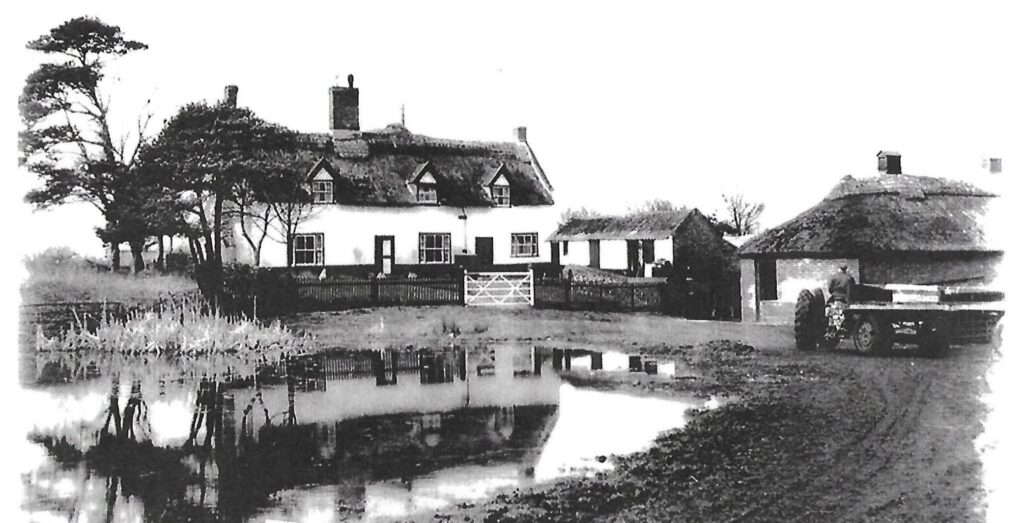
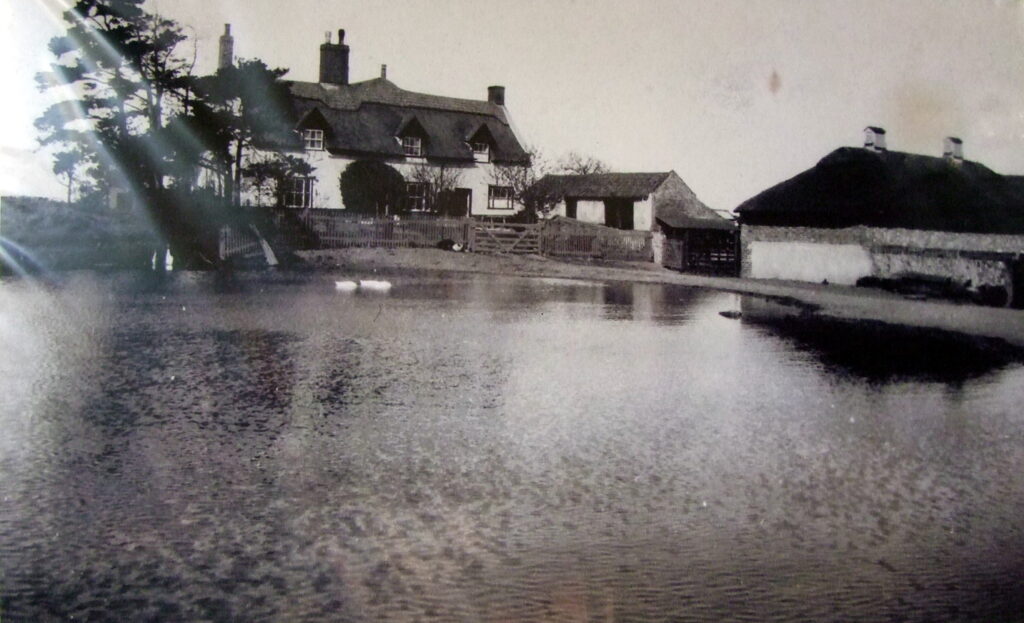
Part 4. 1800 to 1899 (The Creasey/ Garnham/ Rising/ Pearse period)
At some point before 1812 the Creasey family had acquired Moregrove. There are records that say William Creasey, a well-off grocer from Martham, and his wife Mary Robins, who was from Itteringham, had persuaded Richard Garnham to leave Moregrove where he had been a farm tenant for some years to take up the farm tenancy of their Itteringham Manor in 1789. Richard was born in Martham in 1759 so had probably farmed Moregrove for about 10 years.
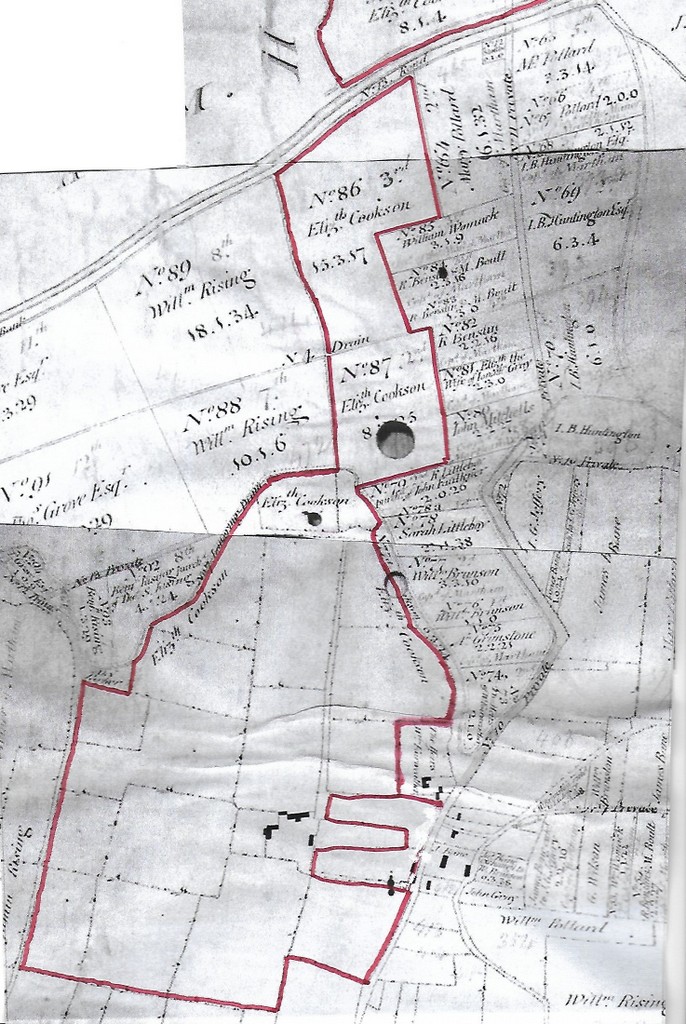
William Rising was farming at Moregrove from about 1789 until about 1797 when he moved to West Somerton to take over that estate after his father had died. William was a ratepayer, churchwarden and overseer at Martham during this period and was probably a tenant of William Creasey who also died in 1797 at Great Yarmouth.
By the time of the 1812 Inclosure Award Moregrove was owned by a widow called Elizabeth Cookson. She was a Creasey and one of the daughters of William Creasey & Mary, nee Robins. Elizabeth had six siblings two of which were Diana & Ann Creasey. Elizabeth had married Joseph Cookson on 20th September 1787 at Great Yarmouth but Joseph died in 1799. In 1812 she was the freehold owner of Moregrove consisting of 112 acres of land plus a house, barn, stables, outbuildings and a fishery. The plots she owned were listed as being Nos 62, 63, 86, 87 & 144. It is pleasing to note that her holdings included a fishery which must have been the original Cobham Fishery probably at plot No144. The Moregrove plots she owned are shown on the map to the left.
Elizabeth died in 1825 having outlived all her siblings except Diana who was a well-off spinster and lived in London and was probably unsuited to farming. This Diana was the well-known lady who left a legacy to provide education for six poor girls at the village school. In her Will, Elizabeth left Moregrove (then spelt Moregrave) equally and jointly between her four nephews: William Creasey Ewing (1787-1862), Robins Purdy (1780-1842), William Creasey Purdy (1784-1859) and George Purdy (1789-1846). This arrangement made things very complicated and they had to go to law to get it sorted out. One way or another it must have been resolved because after the others had died the last to survive was William Creasey Ewing and he sold Moregrove to Benjamin Rising (1775-1835) who had been the tenant farmer there since at least 1812 throughout the joint ownership confusion.
The mystery was, how had Elizabeth Cookson, nee Creasey come to own Moregrove in the first place? The obvious answer was through her husband’s Cookson family but Joseph’s Will makes no mention of Moregrove and he came from a family deeply connected with the Royal Navy and other military ancestors from Shropshire who never seemed to have any connection with Norfolk. Joseph and Elizabeth were absent owners who lived in London. This leaves the possibility of Moregrove coming via the Creasey lineage. This route also seems unlikely; her father was a grocer in Martham and her paternal great grandfather and great, great grandfather were both tailors. It is possible that ‘the money’ came from her mother’s side of the family Mary Robins. The Robins were from Itteringham, near Aylsham and over three generations had raised themselves up from being the village blacksmiths to Lords of the Manor mainly achieved by Mary’s grandfather Thomas Robins (1653-1726) who built Itteringham Manor House – see below. The Manor House came down through the family and when Mary’s father, another Thomas, died in 1732 she inherited the Manor from him. In 1732 Mary would have had no claim to her property as a married woman and legally speaking her husband, William Creasey would have had full control and could do whatever suited him regarding ‘her’ property. Perhaps this is why he is always referred to as the ‘well-off grocer of Martham’.
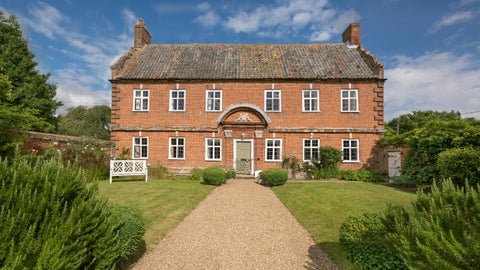
Returning to Benjamin Rising who was the tenant at Moregrove in 1812 he was part of the Rising family dynasty of farmers and landowners of Martham and West Somerton. He was closely connected to the Creasey family as an executor of the Wills of William & Mary. Benjamin had purchased Moregrove from William Creasey Ewing the grandson of William & Mary and appears in the Register of Electors as living at Moregrove between 1832 and 1835.
Benjamin’s second wife, Mary Clementina, was a Garnham (the daughter of Richard who had transferred from Moregrove to go the Itteringham). Her parents were therefore neighbours of the Robins family at Itteringham. She was one of seven children of Richard Garnham & Mary, nee Cubitt. One of her brother’s was William Henry Garnham (1797-1862) who married Elizabeth Clabon (1802-1881) in 1830. Benjamin & Mary did not have any children; she died in 1832 and when Benjamin died in 1835 his Will made it clear his brother-in-law William Henry Garnham was to be his main heir. This seems somewhat odd as he had 13 siblings and at least seven of them died after him but they did not get Moregrove. Perhaps he though it was only just that the inheritance should return to the Garnham/Robins side of the family rather than add to the Rising family fortunes. Thus, Moregrove is listed in White’s Directory as belonging to Mr Wm. Garnham.
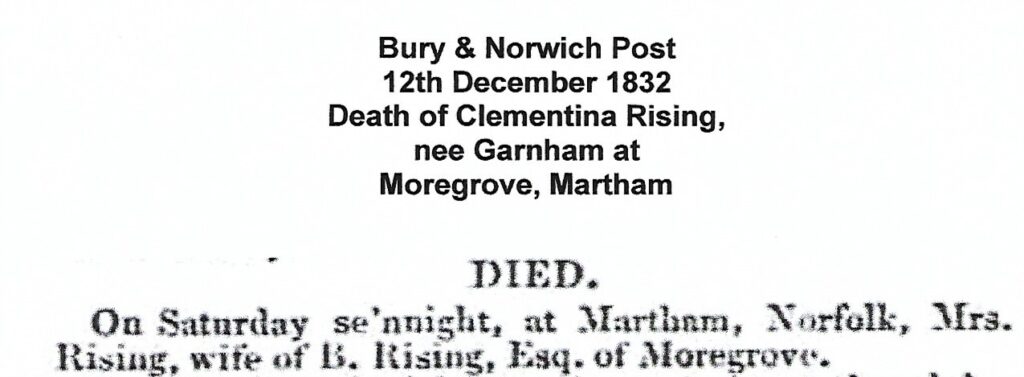
Announcement of the death of Clementina Rising, nee Garnham in the Bury & Norwich Post dated 12th December 1832. She was the wife of Benjamin Rising.
Summary: Itteringham was the common denominator for the Robins and Garnham families.
The Robins became wealthy and the money came to William & Mary Creasey, nee Robins.
William and Mary persuaded Richard Garnham to move from Moregrove to Itteringham as the tenant farmer.
William & Mary left Moregrove to their daughter Elizabeth.
Elizabeth left Moregrove to her four nephews the last survivor of which was William Creasey Ewing.
William Creasey Ewing sold Moregrove to Benjamin Rising.
Benjamin Rising left Moregrove to William Henry Garnham.
This complex situation may be easier to follow with this family tree.
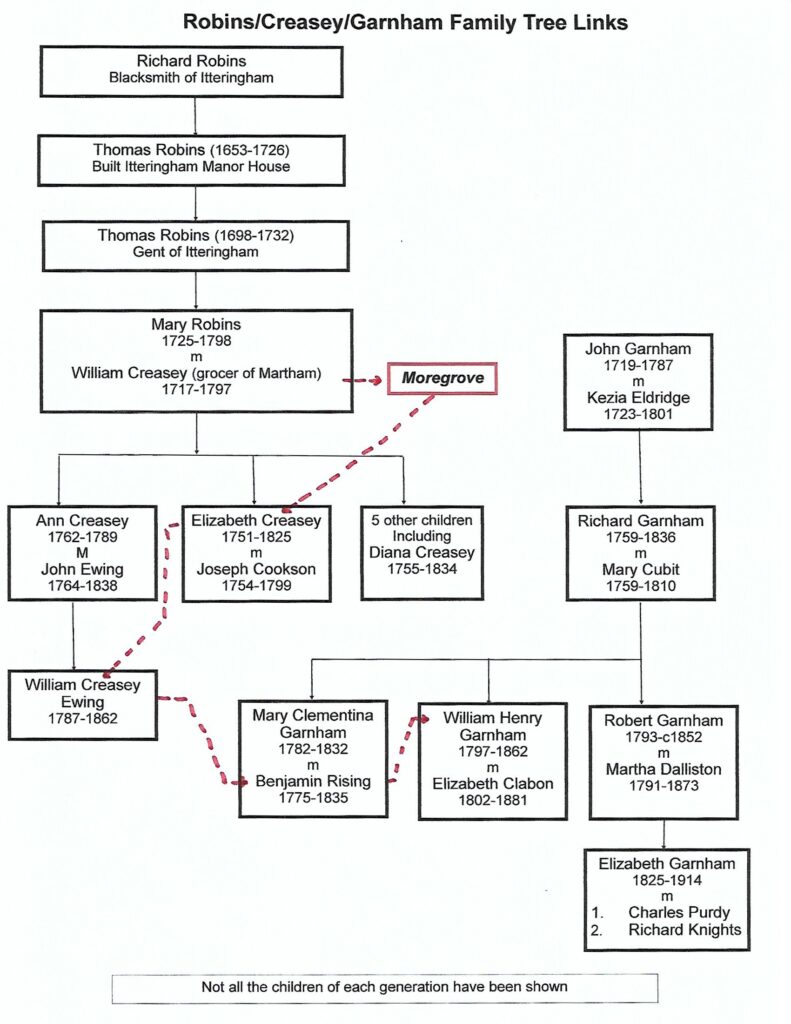
The change of ownership from Benjamin Rising to William Henry Garnham happened in 1835 a few years before the 1841 census which is interesting because Moregrove was occupied by an entirely new person to Martham in 1841 and he was Silvanus Grove Hillersdon. Silvanus was born in Barnes, Surrey and was a yeoman farmer. He moved frequently in census terms and had gone to Stalham by 1861 and moved on to North Walsham in 1871 where he lived on ‘income from dividends. The owner of Moregrove remained William Henry Garnham in 1841 who was a very successful silk merchant and draper living at 30 Red Lion Square, London where his business was. William also had a brother, Robert, who was living and farming at Itteringham in 1841.
The 1842 Tithe Award confirms the above and much more. At the time of the Award William Henry Garnham owned Moregrove and it was still occupied by Silvanus Grove Hillersdon. The plots owned by William and occupied by Silvanus were almost identical to those that made up Moregrove in 1812 but plot number 429 formerly owned by Benjamin Rising in 1812 had been added. The 1842 plot numbers that made up Moregrove were 423 to 433 and 435, 436, 440, 445 to 450 & 461 & 462, 713, 714, 716 & 717 as shown on the right. In addition, William owned even more land inherited from Benjamin Rising which was mainly along the west side of Ferrygate as well as Clarkes Farm all of which was occupied/farmed by his cousin Richard Garnham. In all William owned just over 227 acres in Martham. The Moregrove estate map for 1842 is shown here.
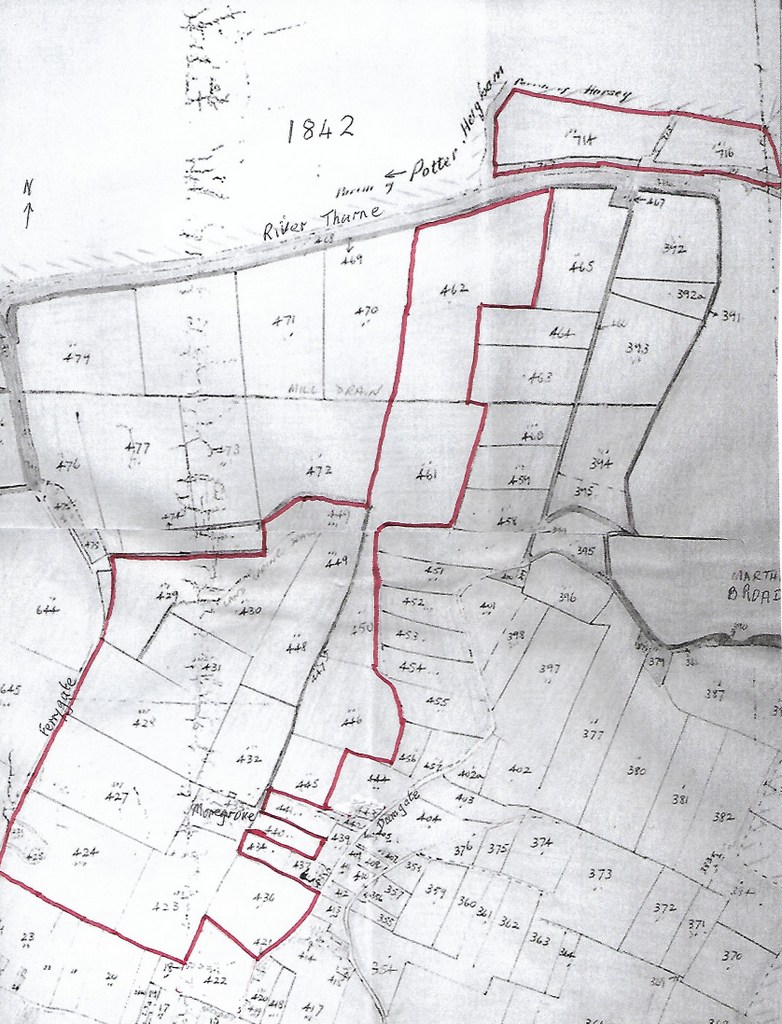
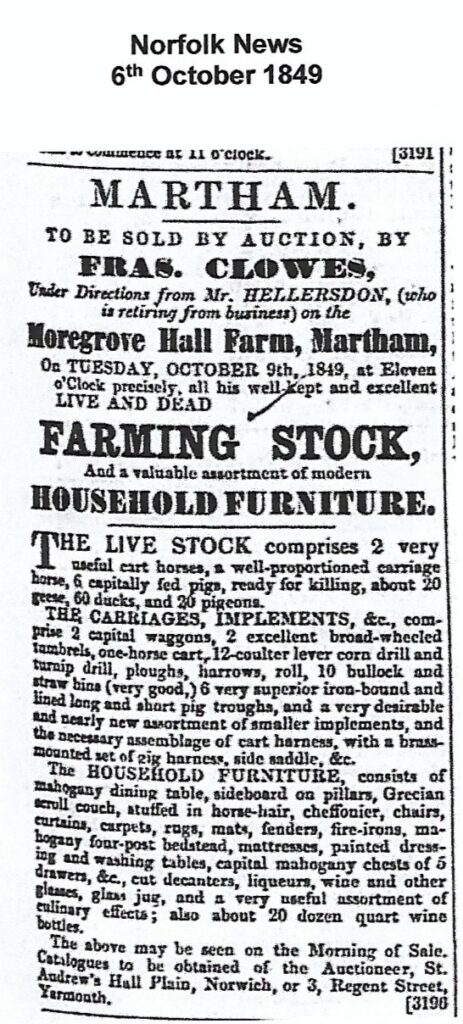
Silvanus Hillersdon was listed in the Martham Register of Electors in 1844 & 1845 and also in White’s Directory of 1845 and he continued living and farming at Moregrove until October 1849 when he retired from farming according to this auction advert published in the Norfolk News on 29th September and 6th October 1849. This auction was for his farming stock and personal effects only. Moregrove Hall and the estate remained in the ownership of William Henry Garnham and by all accounts his brother, Robert, moved back from Itteringham to live and farm there.
By April 1851 Robert Garnham had returned to live at Moregrove with his wife, Martha, daughter Elizabeth plus his sister-in-law Elizabeth Daliston and niece, also, called Elizabeth. Moregrove was actually named as such on the census form and consisted of 127 acres and Robert employed five labourers.
It is possible that Robert was in poor health at the time of the 1851 census because on 24th May 1851 the advert shown below appeared in the Norwich Mercury advertising the farm as available for renting from July that year. We do not know exactly when Robert died but it was sometime between April and 10th November 1852 when his daughter married Charles Purdy.
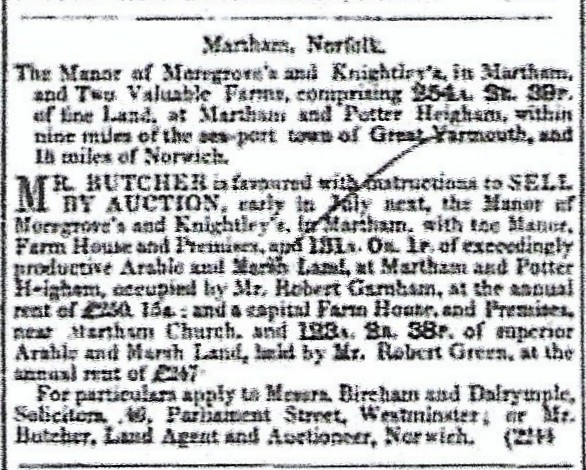
The death of Robert must have been a turning point for William. He was running a very successful business in London in the silk trade and obviously decided to bring his farming interests to a close. In July 1853 the Norfolk Chronicle and other newspapers ran adverts listing both his Moregrove and Clarkes Farms for sale by auction in London. The adverts (one shown on the right) were quite detailed and targeted the gentleman farmer market. Moregrove was a five-bedroom farmhouse with dairy, two barns, yards, cattle sheds, stables, hay house and piggeries as well as equipment. There was a garden, land and marshes adding up to 131 acres in total. The tenant at the time was Robert Belson.
The buyer of the whole of the property was Reverend George Pearse who paid £10,900. Rev. Pearse was born at Carlton Colville, Suffolk in 1793 and was the Vicar at Martham from 1834 until he retired in 1876.
Rev. Pearse continued the tenancy given to Robert Belson and Robert appears in the Register of Electors as living at Moregrove from 1853 to 1862. In 1861 Robert and his family were listed in the census for that year living at Moregrove. He was 33 and was born at Repps. Married to Mary they had three sons and they also employed a nurse and two servants. The census form says he farmed 140 acres and employed 5 labourers and 3 boys on the land. The entry in the 1861 census form for them is shown below.
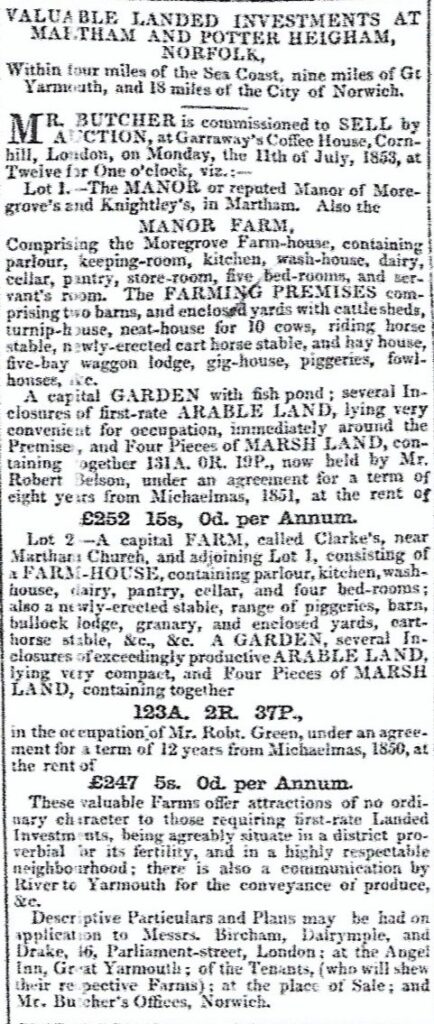

Robert Belson decided to give up farming and leave Moregrove. An advert appeared in the Norfolk Chronicle on 27th September 1862 listing his farming equipment for sale as shown below. White’s Directory of 1864 tells us that after leaving Moregrove he became a wherry owner and corn & seed merchant.
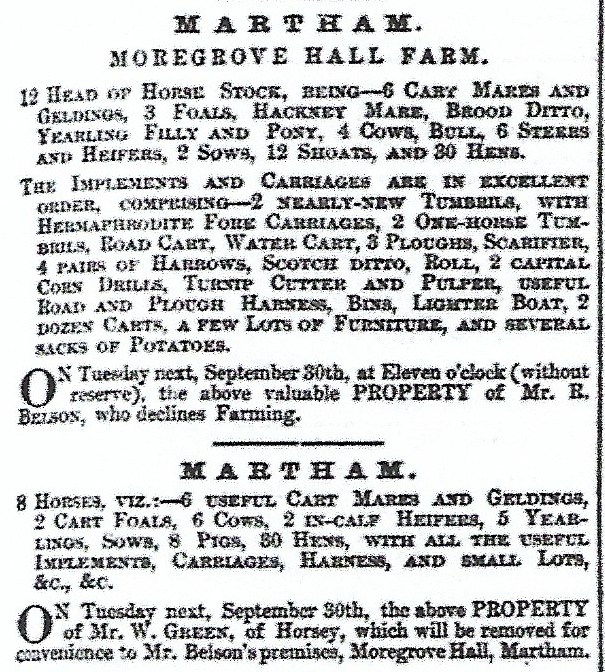

Rev. Pearse was still the owner and his tenant following Robert Belson was Richard Knights who came from a long established Martham family. The maternal side of his family were the Pollards who were also a long standing Martham farming family. Richard was married twice; his first wife was Ann Barber and in 1869 he was listed in the Post Office Directory as a farmer at Moregrove. From 1863 to 1871 he also appeared in the Register of Electors at Moregrove. The census of 1871 shows that Robert & Ann were at Moregrove farming with the help of four men and a boy. Robert’s time at Moregrove came to an end later in 1871 following this advert published in October that year saying he was leaving the occupation. After they left Moregrove Ann died in 1877 and Richard went on to marry his second wife Elizabeth Mary Garnham in 1882 who was the very same lady we have met before living at Moregrove in 1851 and whose first husband was Charles Purdy who had died in 1880.
The next tenant was only at Moregrove for about three years. He was Thomas Sword Riseborough from Newton Flotman which is about eight miles south of Norwich. He appeared in the Register of Electors at Moregrove in 1873 and 1874 but on 12th September 1874 the Norwich Mercury carried the advert shown on the right saying he was suffering from ill health and was giving up farming. Thomas died age 34 only a couple of weeks later on 23rd September.
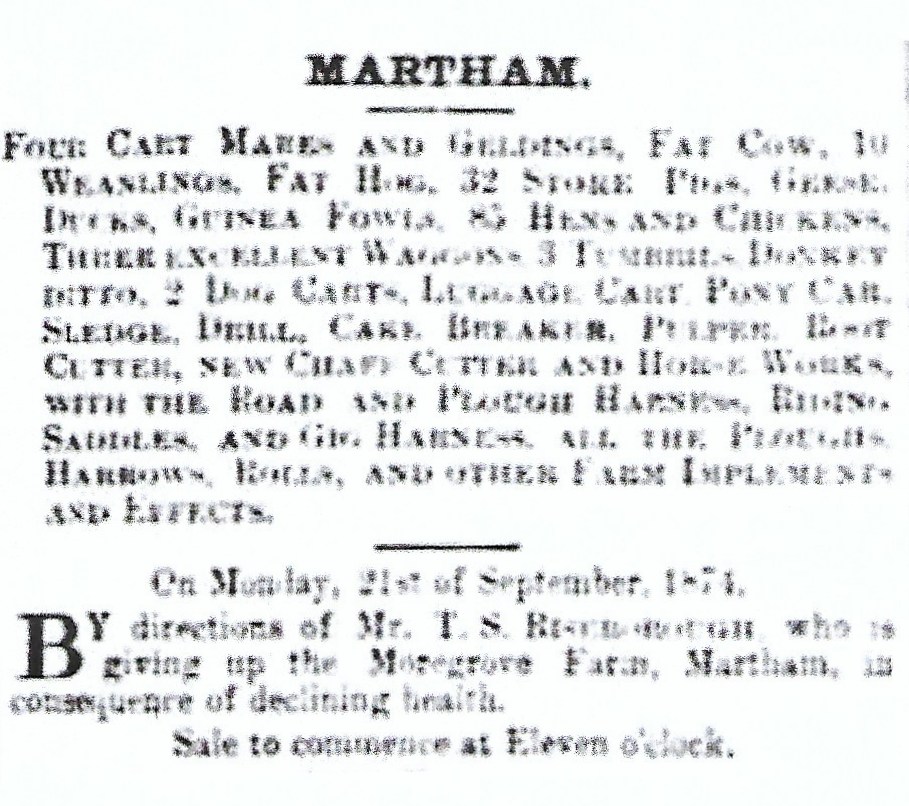
Robert Betts Collyer became the next tenant farmer at Moregrove whilst his son George was at Clarkes Farm according to Kelly’s Directories of 1874 and 1879. George transferred to Moregrove in 1880 and his father, Robert, died there on 22nd April 1880 at the age of 86.
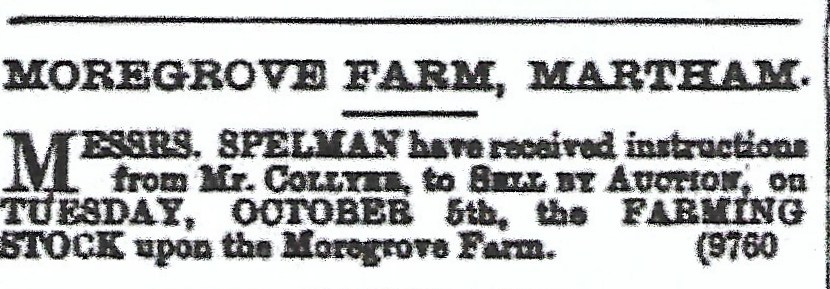
The Norwich Mercury published this notice on 18th September 1880. Moregrove Farm, Martham. Messrs Spelman have received instructions from Mr Collyer to sell by Auction on Tuesday 5th October 1880 the farming stock upon Moregrove Farm.
The tenants of Rev. Pearse kept on coming and going and by the time of the 1881 census we find that Charles Nichols had taken on the farm. He also appears in the Register of Electors from 1882 to 1888 as being at Moregrove. He was married three times and in the 1881 census he was listed with his third wife, Mary Ann, nee Canham and four sons running the farm of 116 acres employing two men. His first wife was Mary Ann Cator who died in 1856, the second was Sophia Turner who died in 1861. Charles and his third wife also appeared in the 1891 census as farming at Moregrove.
During the course of Charles Nichols tenancy the owner of Moregrove Rev. George Pearse died on 5th September 1882. He had owned both Moregrove and Clarkes Farm and the following year his Executors put them up for sale. Their freehold was advertised in the Norwich Mercury on 9th June 1883 as shown here on the right.
The purchaser was Charles Palmer who was another investor rather than a farmer. He was a MRCS surgeon and lived at 44 King Street, Great Yarmouth but was born in Lincolnshire. Charles Nichols continued to farm Moregrove whilst it was owned by Charles Palmer.
Mr Palmer’s ownership did not last long because he died on 12th September 1884 and the farm went on the market yet again at an auction held at The Star Hotel, Great Yarmouth. A copy of the advert is shown below.

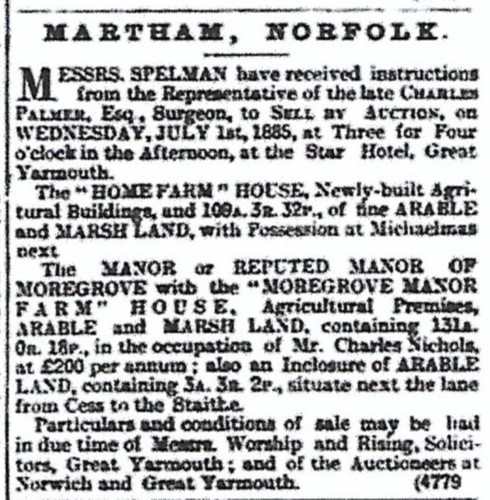
One Executor to Charles estate was his brother John Robert Palmer a farmer from Oulton Broad. Charles was a bachelor and died intestate so it took a while to sort out his estate and Moregrove was not advertised for sale until 10 months after Charles had died and then the auction had an unusual outcome because the Norwich Mercury dated 3rd July 1885 ran the article – shown below – saying Moregrove was not sold and was withdrawn.
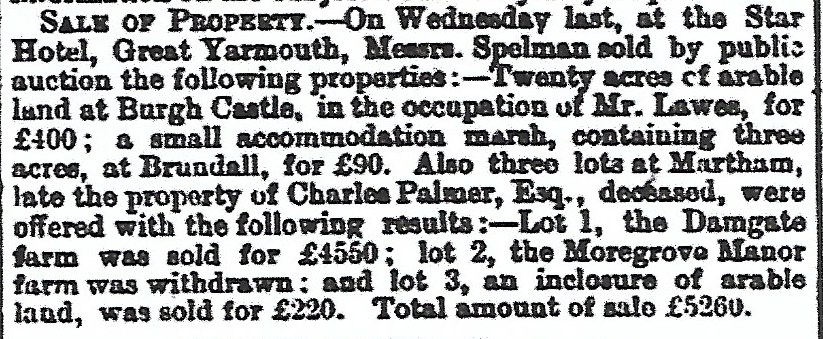
It seems that Charles Palmer’s brother, John, had arranged to buy Moregrove from the estate of his brother or held it as a Executor because John Robert Palmer was listed in the 1885/86 Register of Electors for Martham on account of Moregrove whilst Charles Nichols still occupied and farmed there. Charles was also living there in 1890, 1892 & 1896 according to Kelly’s Directories for those years. In addition, the 1891 census listed him as being there with his third wife Mary but his fairly long spell there came to an end when he died on 18th February 1897 aged 71. In his Will Charles Nichols gave specific instructions that his wife was to inherit everything and that she could carry on farming assisted by his executors, one of which was his brother. Upon her death all his real estate was to go to his son Edmund.
Part 5 – 1900 onwards
The terms of Charles Nichols Will were kept and his widow Mary stayed on at Moregrove after her husband’s death and she was listed as a farmer there in the 1901 census. Also living with her were two of her granddaughters Rosa (16) and Maud (6). Mary died in 1909 but Moregrove remained the home of the next generation of the Nichols family when Edmund, the son of Charles and Mary (his 3rd wife) moved in. He is listed in the 1911 census living there with his wife Julia Ann, nee Gallant, and their large family which totalled 12 in 1911 and are listed on the census form shown below:
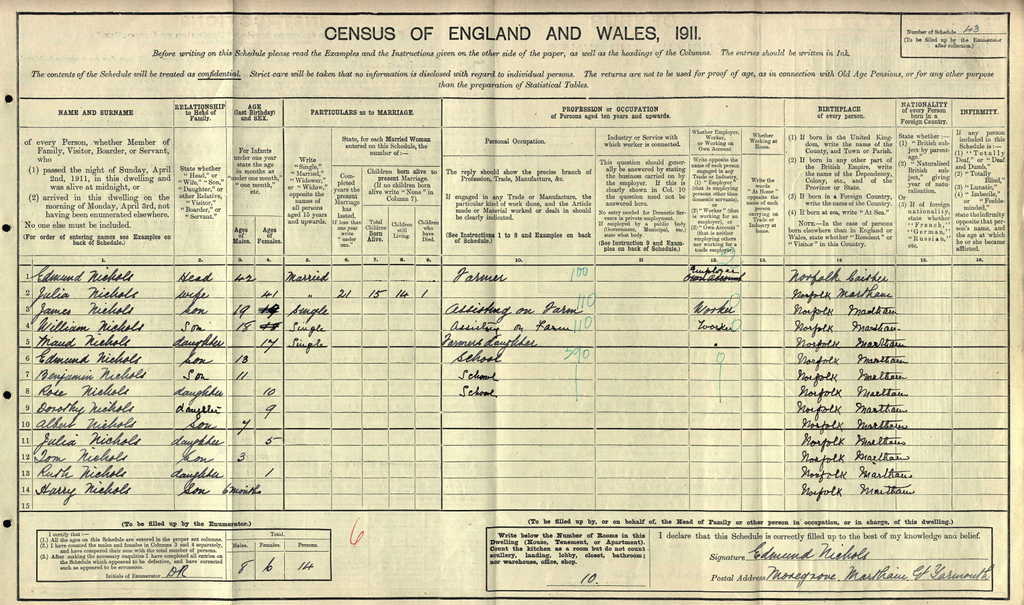
Edmund and his family remained at Moregrove until around 1919 by which time the Nichols family had lived and farmed the land there for almost 40 years. As the First World War came to an end a new era for Moregrove was about to dawn. On 31st May 1919 the Yarmouth Independent newspaper featured the advert, shown below, advertising not only the farm but the actual Lordship of the manor as separate lots to be auctioned.
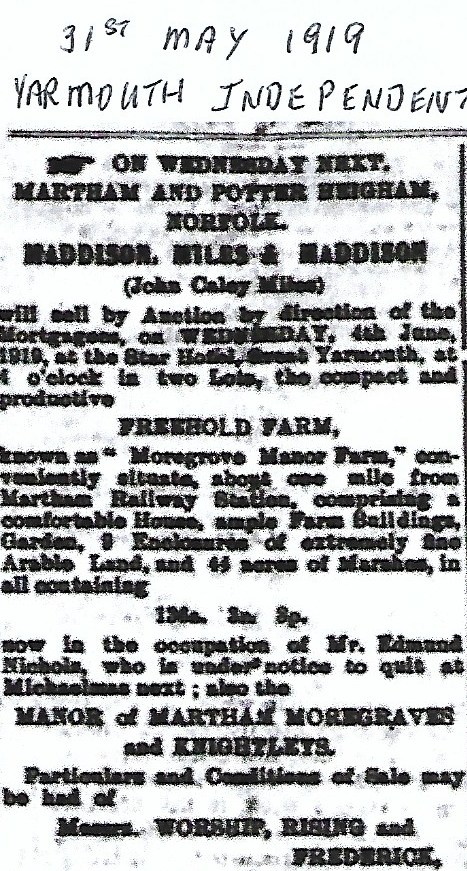
The sale resulted in a series of different outcomes. The buyer of the Lordship of the Manor of Moregrove was Mr Frederick Joseph Newman for £50 who was a solicitor from Great Yarmouth and would have become the holder of the title Lord of the Manor of Moregrove. The paper title would have given him few rights beyond the farm or income from its land as they had been given away by previous generations.
George William Chapman was the successful bidder for the actual farm and house which included 136 acres 2 rods & 34 perches paying £4,500 for the lot. In addition, he was the successful bidder for three other lots separately listed on the same day. One was for a nearby house with a fruit garden for which he paid £480; lot two consisted of two adjacent cottages which cost him £80 and lot three were three marshes next to Damgate Wall next to the River Thurne containing 4 acres 3 rods & 27 perches which cost him £125. These acquisitions would be the start of four generations of the Chapman family farming Moregrove right though to the present day.
George was a butcher as well as a farmer and Chapman’s butchers is as well known in its setting to the south of the main pond in the centre of the village as the family have been for several generation.
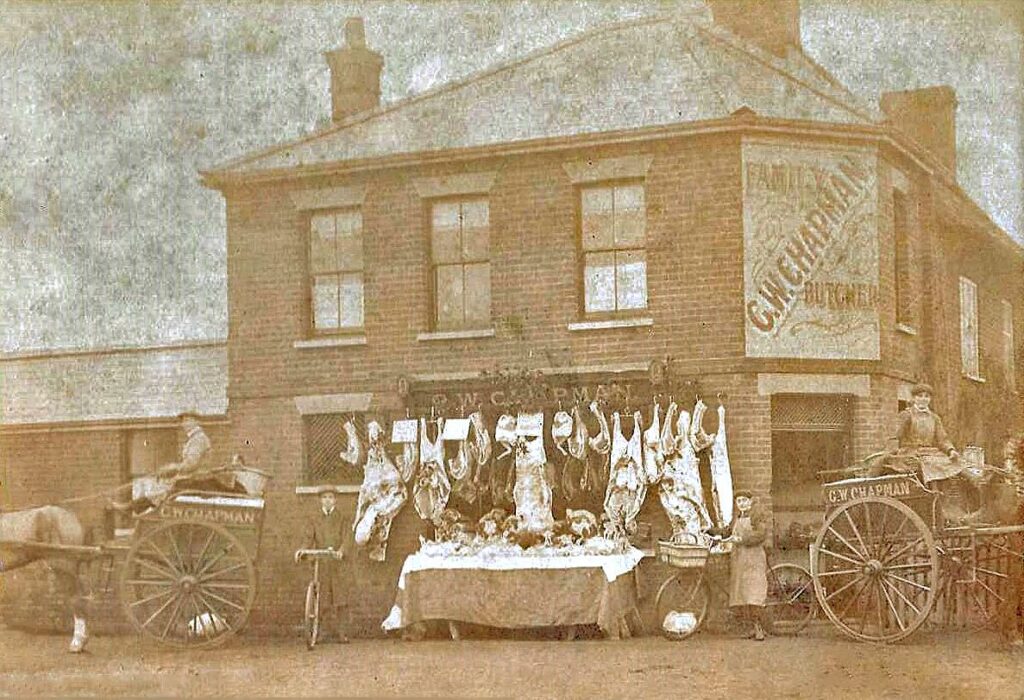
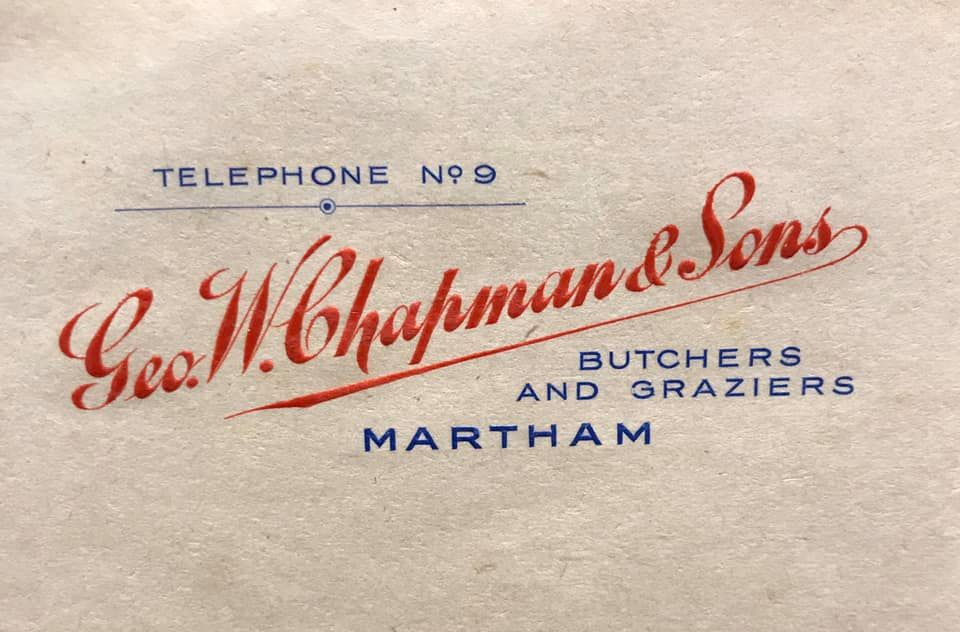
The Chapman family have continued to successfully farm Moregrove for the last hundred years but mostly lived at nearby Clarkes Farm in Staithe Road. Moregrove Farmhouse did not last quite so long; it was occupied by a succession of tenants for a long time, three of which were John & Madeline Burlingham in 1939, Edward & Grace Wingfield in 1948 and Ted & Beryl Barker in the 1950’s but was eventually demolished in the 1970’s(5) and has not been replaced.
Since writing this page a reader has been in touch with a story about her father, Douglas, who as a boy lived at Moregrove Farm during World War II with his parents Leslie & Frederica Jones. Her father told her a story of being shot at twice and on one occasion he was so scared he cycled right through the farm pond and straight into the kitchen where his mother promptly scolded him for bringing his wet, dirty bike into the house.
The War Years 1939-1944
The Jones family shared the farmhouse with a family called Larter for a while during the war years. They had a very young son called Joe who was to go on to be a significant local figure and later wrote a book about his life called ‘Serendipity’. He has kindly allowed me to published extracts from it of his memories of being a boy living at Moregrove. (Source: ‘Serendipity’ by Joe Larter. ISBN 976-178035-679-2. A recommended read).
Many people will have heard of Joe Larter the inspiration behind Pleasurewood Hills, Sealife Sanctuaries at Great Yarmouth, Hunstanton and Hull, the Bure Valley Railway, the original Gunton Hall holiday centre, builder of 100’s of local holiday chalets plus the Willows estate in Martham and (with partners) the Shrublands estate in Gorleston as well as many other developments. But….…not many people know that he was born in Black Street, Martham and spent his early childhood days living at Moregrove.
Born in 1939 to local builder Oswald (Ossie) & Helen Larter he came into the world accompanied by his twin sister Mary. Joe recalls how in those early days of the war it was difficult to find rented accommodation, but a friend of his father called Billy Chapman owned a rambling farmhouse occupied by tenants, a family called Jones. They agreed to sharing the farmhouse called Moregrove. Joe says:-
“Moregrove Farm became our new base, and a more idyllic home for children of our age could not be imagined. Sadly, Moregrove is no more, but we happily shared with the Jones family – for us, one big room downstairs, plus a scullery/kitchen and just one big bedroom upstairs, we twins at one end with Mother and Father at the other. No indoor facilities at all, with a ‘thunder-box’ toilet in the backyard and a hand-pump for washing water from the pond nearby. All this was quite normal for the day, with a weekly ‘nightsoil’ cart calling at each house to empty the outside toilet.”
He goes on: “Image the effort required of a mother in those days, with two babies and a husband; cleaning, washing, laundry, cooking and looking after an old farmhouse – all without vacuum cleaners and the electrical aids we take for granted today. Washday was always Monday and for drying there was an area near the orchard called ‘the bleach’ with wires, strings and props to help. Some laundry was simply laid on the crop of stinging nettles to dry out. Another aid that did not exist was, of course, the washing machine but also we had no washing powder. The lady doing her weekly laundry had to manage with a boiler and large blocks of yellow or green ‘carbolic’ soap, rubbing out stains by hand on a corrugated ‘washing board’.
“Situated in the centre of a real working farm, still with carthorses to plough and steam traction engines to thresh the harvest, the house had neither running water nor heating, other than one coal fire. A portable oil stove was in the scullery to cook on, but there was no electricity for lights or anything, and I remember pump-up paraffin lamps hissing away and forever burning out their globe-type wicks. I believe that, in the last years at Moregrove, we did have a battery wireless set on which Father and Mother could follow the progress of the war. Weekly bath-time on a Friday was a tin bath in front of the fire, filled from a coal-heated water boiler in the kitchen, and the water carefully shared.”
“The Jones family – father Leslie (known as Harry) worked on the farm. They had three children so there were plenty of adventures for the five of us around the farm and we were allowed a freedom to roam and play we would never have been given today. Ponds, farm machinery, haystacks and straw stacks, and dykes, all not then seen as ‘elf and safety’ dangers.”
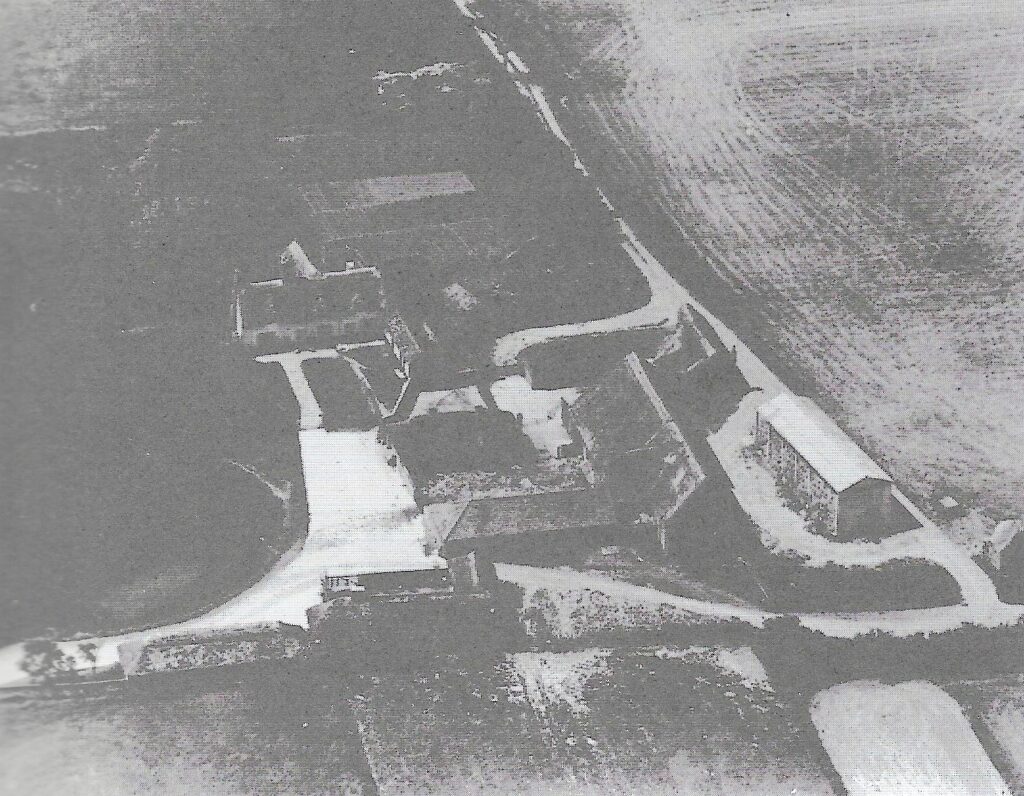
“Harvesting was the fun time, still carried out with a steam ‘set’, with a gang moving from one farm to another. Usually the team, with a big traction engine, would arrive at the next farm in the early evening, to be ready to steam up early next morning.”
“The farm had a goodly herd of cows, and milking took place each day in the ‘parlour’ at the entrance to our garden. Milking was very early in the morning. The whole farm was based around the horse. Every day carthorses would be brought out for whatever tasks and were lined up at the edge of our pond, which was their watering hole. Harry Jones seemed to be the main horse man and it was a wonder to see him and his teams plough a field with dead accuracy. Each horse responded to its own name, Rosie, Betsy and so on and, with just his eye Harry ploughed the furrow as if they were drawn with a ruler.”
“I still love the Norfolk marshes and their calm wilderness with an old windmill in the distance and maybe that stems from our time at Moregrove.”
The old house may have been demolished but a pair of barns on the north side of the site faired a little better and were given Grade II Listed status in 1987 being described as circa 18th century barns of brick and thatch. The western barn has central double full height timber doors on the north side. One slit ventilation light either side. Gabled roof. Tumbling in west gable head. Stabling built to the south. There are roof tie beams on knuckle braces, two tiers of butt purlins and collars. Both barns share a common gable. The eastern barn is entered from the north side through full height double timber doors set to the right of centre with two stepped buttresses to the left. Between the buttresses is a rectangular honeycomb ventilation panel. The south side has an opposing gabled transept entrance with double timber doors and a tumbling in gable head(14). High up inside the west gable end the name Benjamin Rising (1775-1835) is inscribed but it is soot covered indicating perhaps that the barn once suffered a serious fire in the thatch.
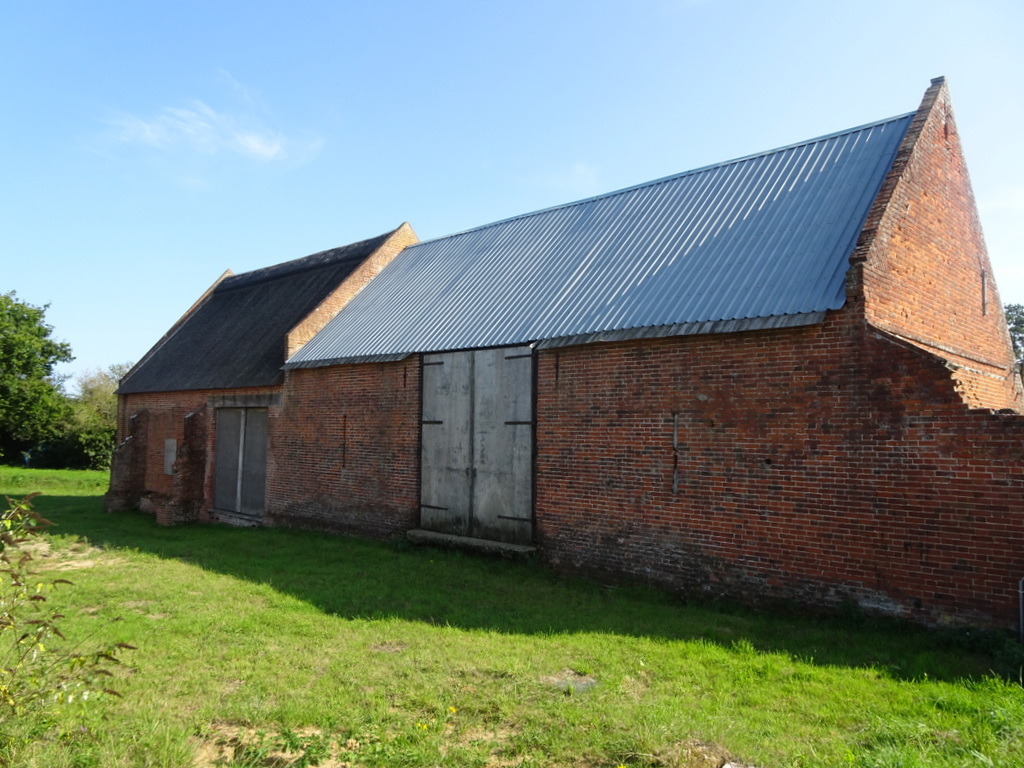
Two outhouses that were once part of the Moregrove farmyard group were converted to homes in the 1970’s to make splendid homes with decks that overlook the pond as shown below.
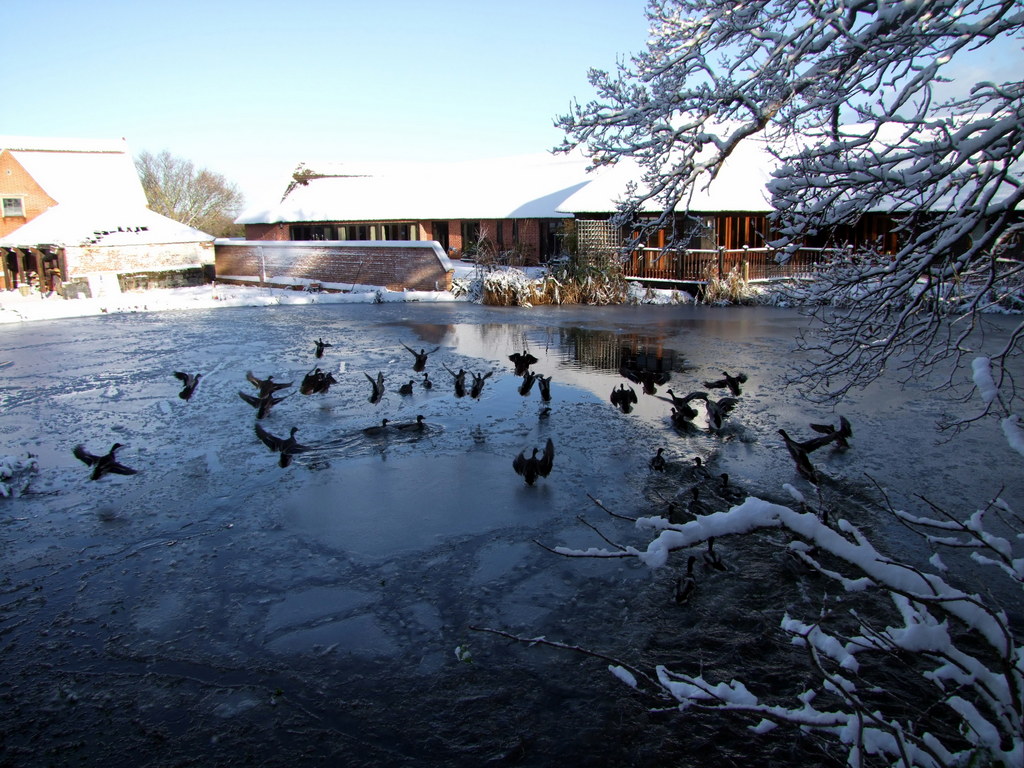
As mentioned above the present owner of the farmyard buildings (not the farmland) is Jeremy Moore a retired engineer and world class vintage aircraft restorer. He purchased the buildings from the Chapman family in 2000 and set about restoring the barns to make a home. So, another chapter in the long history of Moregrove began and has resulted in the discovery of the stonework and other historic artifacts at the site. Jeremy was particularly pleased to be able to buy the buildings because Charles Nichols is his great, great grandfather on the maternal side of his family.
Moregrove is probably one of the most tangible historic sites in Martham and as you can see it is connected with many people across great timescales many of which I have provided links to so please enjoy the wander through Martham history by looking at the connections Moregrove has with other aspects of the village.
Photographs
Click a thumbnail for a close-up and scroll through all the images from there.
Sources:
(1) ‘An Essay Towards a Topographical History of the County of Norfolk’ by Francis Blomefield.
(2) http://www.british-history.ac.uk/report.aspx?compid=78420.
(3) http://www.guntonfamily.com/history.php. “History of the Gunton Name”.(4) http://www.knight-france.com/geneal/names/2390.htm(5) ‘Medieval Flegg’ by Barbara Cornford.(6) https://www.surnamedb.com/Surname/Gunton#ixzz6UdjJKczC
(7) http://awtc.ancestry.com/cgi-bin/igm.cgi?op=REG&db=:2870842&id=I00654&ti=5544>:
(8) Sketch of the Life of Dr. William Gunton by Byron Sunderland. Published 1878.
(9) In the Domesday Book Martham was held by the King, Count Alan, the Bishop of Thetford and St Benet’s Abbey. The Bishop of Thetford’s holding was the most valuable and included a church with 50 acres of land. The present St Mary’s dates mainly to the 14th and 15th centuries. The 15th century chancel was built by Robert Everard, the architect of Norwich Cathedral’s spire. An archaeological watching brief was carried out by the NAU in 1999 during the lowering of the floor in the west tower revealed the foundations of a round tower, probably dating to the 12th century, probable medieval graves and a small lead-melting pit containing medieval window glass.
(10) History and antiquities of the County of Norfolk (Volume 4).
(11) Buttles of Moregrove Manor 1514 held by the Norfolk Records Office.
(12) The Manors of Cawston and Meys, or Sterlings, were in the South Erpingham area of North Norfolk.
(13) ‘A New Hero of Norfolk Agriculture’ by Elizabeth Griffiths.
(14) https://historicengland.org.uk/listing/the-list/list-entry/1152416.
(15) In his ‘own right as a lay fee” meant the highest estate that an individual could have because it was total ownership of all land and structures attached to it. It was complete ownership absent of all conditions limitations or restrictions.
(16) Herbert de Losinga was once Abbot of Ramsey. Consecrated Bishop of Thetford before 27th January 1091. Moved See to Norwich 1094/95, although not consistently called Bishop of Norwich until c1103.
(17) ‘See’ is the seat of the area of a bishop’s ecclesiastical jurisdiction.
(18) William Beaufoe’s extensive land holdings were mainly in the county of Norfolk and Suffolk. He was the Royal Clerk to William the Conqueror before he was nominated to the See of Thetford on 25th December 1085 and consecrated Bishop in 1086. He died before 27th January 1091. He was sometimes recorded as William de Beaufai, William of Bello Fargo or William of Belfou.
(19) William de Turbeville, sometimes recorded as William Turbe, was consecrated Prior of Norwich in 1146 or early 1147. He died in office on 16th January 1174.
(20) Blomefield’s original entry reads: “The Church is dedicated to St. Mary and was a rectory, valued at 37 marks, and given by Roger de Gunton with all its appurtenances, with the consent of Nicholas his son and heir, in the presence of William de Turbeville Bishop of Norwich for the redemption of his soul, to the prior and convent of Norwich. Witnesses, Abbot Danyel (of Holm), William and Roger archdeacons, William de Hasting, Alan de Bellofago, and this was about the year 1160 and was confirmed by the aforesaid Bishop.”
(21)Blomefield’s original entry reads(1): Matthew de Gunton, granted by fine in the 8th of Henry III. to William, prior of Norwich, the advowson of the church of Martham; who received Matthew, and all his men, or tenants to be partioners in all the prayers of their convent; and in the following year, he also gave 9 acres of land here to master Adam de Wausingham, and his successors, in the church of St. Mary, of Martham, Adam paying to him 40s per annum.
(22) Blomefield’s original entry reads(1): Roger de Gunton, probably son of Matthew, gave by deed sans date, to God and the church of the Holy Trinity of Norwich, a messuage here, and 12 acres of arable land adjoining, late Mr. Adam de Wausingham’s, free from all services, for the life of Isabell de Castre his mother-in-law, and after her decease, to the priory, paying to him and his successors 2s. per annum.—witnesses, Reyner de Burgo, William de Stalham, Knts. Robert de Mauteby, &c.
